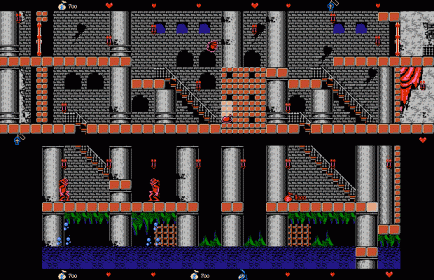The first stage (or rather, three stages) of Castlevania stands one of those iconic gaming structures, like Super Mario Bros. World 1-1 and the Green Hills Zone of Sonic the Hedgehog. Sequels have recreated, re-presented, and otherwise regurgitated the layout, enemies, and mechanics of this set of screens. Sometimes it’s a light reference, sometimes — as in Castlevania Chronicles — a mocking inversion of expectations. Usually these renditions communicate the fact that the player has arrived at Castlevania proper, whether it’s simply the ultimate destination along the way (as in Dracula’s Curse), a hidden ruin within the labyrinth (as in Dawn of Sorrow), or both (as in Simon’s Quest).
 Map image scraped from neoseeker.com
Map image scraped from neoseeker.com
There’s a reason for this: Castlevania had a really great opening level. Its graphics are visually striking, it creates a convincing sense of place — a grand entranceway that opens into a room that can only be passed by circumnavigating it through the crumbling cellar — and it gently nudges the player to learn the rules of the game. Stage 01 lacks any real platforming challenges, though the raised balcony offers an optional opportunity to get a handle on navigating stairs. Stage 02 presents the game’s first platform threat with the open gaps in the cellar. The fish men could potentially knock you into one of the holes, but they leap into action a full whip’s length away from the player, posing a present but not urgent threat. And Stage 03 offers very little in the way of danger, providing nothing more than a run-up to the more-or-less toothless first boss, which is practically guaranteed to net you your very first subweapon triple-counter power-up.
That is, provided you manage the find the one in the blocks right beneath the boss — which you may not do your first time through, but you will eventually, because sooner or later you’ll hit one of the numerous blocks scattered throughout the stage that contain hidden items. Once you stumble upon those, you start picking your way through the level hitting everything you can. And even then there are more arcane secrets: Namely, a seemingly inaccessible pair of blocks on the water’s surface that you can reach by breaking a brick above. Kneel on the two lower blocks and a bonus appears above. And you wonder: Where else in the game can I do this?
And the obsession begins in earnest.
Also belonging on that list, really, is the entirety of Kirby’s Dreamland, which if I’m not mistaken has been wedged into every single one of its sequels somewhere (well, except for the weird spin-offs).
Castlevania was one of my biggest influences when I was making Mega Man Powered Up levels. Not because of the ludicrous difficulty levels they reached, but the way that everything in Castlevania seemed to have been deliberately placed so that the architecture supported it, with pillars in the background holding up the otherwise floating platforms and the like. Things randomly flying in the air is such a staple of 2D platformers that a game like Castlevania that at least tries to handwave away the conceit really stands out.
I noticed this exact thing when trying to recreate some Castlevania stages in Powered Up. Not a single platform was simply stuck there; every one of them had some architectural justification. Amazing stuff.